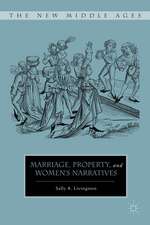Feminism and Avant-Garde Aesthetics in the Levantine Novel: Feminism, Nationalism, and the Arabic Novel: Literatures and Cultures of the Islamic World
Autor K. Hannaen Limba Engleză Paperback – 25 feb 2017
| Toate formatele și edițiile | Preț | Express |
|---|---|---|
| Paperback (1) | 381.21 lei 6-8 săpt. | |
| Palgrave Macmillan US – 25 feb 2017 | 381.21 lei 6-8 săpt. | |
| Hardback (1) | 387.38 lei 6-8 săpt. | |
| Palgrave Macmillan US – 23 feb 2016 | 387.38 lei 6-8 săpt. |
Din seria Literatures and Cultures of the Islamic World
-
 Preț: 394.51 lei
Preț: 394.51 lei -
 Preț: 388.72 lei
Preț: 388.72 lei -
 Preț: 387.75 lei
Preț: 387.75 lei - 15%
 Preț: 641.71 lei
Preț: 641.71 lei -
 Preț: 388.72 lei
Preț: 388.72 lei - 15%
 Preț: 641.20 lei
Preț: 641.20 lei - 15%
 Preț: 640.06 lei
Preț: 640.06 lei -
 Preț: 389.70 lei
Preț: 389.70 lei -
 Preț: 387.75 lei
Preț: 387.75 lei -
 Preț: 387.75 lei
Preț: 387.75 lei -
 Preț: 390.63 lei
Preț: 390.63 lei -
 Preț: 422.90 lei
Preț: 422.90 lei - 15%
 Preț: 588.50 lei
Preț: 588.50 lei - 15%
 Preț: 639.25 lei
Preț: 639.25 lei -
 Preț: 320.40 lei
Preț: 320.40 lei -
 Preț: 383.12 lei
Preț: 383.12 lei - 15%
 Preț: 638.24 lei
Preț: 638.24 lei - 9%
 Preț: 677.46 lei
Preț: 677.46 lei -
 Preț: 386.81 lei
Preț: 386.81 lei
Preț: 381.21 lei
Nou
Puncte Express: 572
Preț estimativ în valută:
72.94€ • 76.36$ • 60.36£
72.94€ • 76.36$ • 60.36£
Carte tipărită la comandă
Livrare economică 07-21 aprilie
Preluare comenzi: 021 569.72.76
Specificații
ISBN-13: 9781349714896
ISBN-10: 1349714895
Pagini: 198
Ilustrații: XV, 198 p.
Dimensiuni: 140 x 216 x 12 mm
Greutate: 0.25 kg
Ediția:1st ed. 2016
Editura: Palgrave Macmillan US
Colecția Palgrave Macmillan
Seria Literatures and Cultures of the Islamic World
Locul publicării:New York, United States
ISBN-10: 1349714895
Pagini: 198
Ilustrații: XV, 198 p.
Dimensiuni: 140 x 216 x 12 mm
Greutate: 0.25 kg
Ediția:1st ed. 2016
Editura: Palgrave Macmillan US
Colecția Palgrave Macmillan
Seria Literatures and Cultures of the Islamic World
Locul publicării:New York, United States
Cuprins
Introduction: Gender, Nation, and War: A New Critical Conjunction
1. The Vicious Cycle: Contemporary Literary Feminisms in the Mashriq
2. The Gendered Subject: Literary Existentialism in Gh?dah al-Samm?n's "Beirut Tetralogy"
3. Sahar Khal?feh's Resistance Literature: Towards a Palestinian Critical Realism
4. Gender Dialectics: Hud? Barak?t's Aesthetics of Androgyny
Afterword: Women Writing War, A Levantine Outlook
1. The Vicious Cycle: Contemporary Literary Feminisms in the Mashriq
2. The Gendered Subject: Literary Existentialism in Gh?dah al-Samm?n's "Beirut Tetralogy"
3. Sahar Khal?feh's Resistance Literature: Towards a Palestinian Critical Realism
4. Gender Dialectics: Hud? Barak?t's Aesthetics of Androgyny
Afterword: Women Writing War, A Levantine Outlook
Recenzii
“The most important achievements of this book is its successful balance between the encyclopedic scope required to prove the existence and the importance of a literary movement and the close readings necessary to demonstrate the movement’s avant-gardism. … Hanna’s Feminism and Avant-Garde Aesthetics in the Levantine Novel represents a valuable intervention in Arab feminist studies, Arab modernist studies, and trauma studies.” (Rania Said, H-Levant, networks.h-net.org, August, 2017)
Notă biografică
Kifah Hanna is Assistant Professor in the Department of Language and Culture Studies at Trinity College, USA.
Textul de pe ultima copertă
Feminism and Avant-Garde Aesthetics in the Levantine Novel examines the aesthetics of existentialism, critical realism, and surrealism in contemporary feminist literature in the Levant. It focuses on the novels of the Syrian writer Gh?dah al-Samm?n (b. 1942), the Palestinian Sahar Khal?feh (b. 1941), and the Lebanese Hud? Barak?t (b. 1952) and argues that their mediations of the Lebanese Civil War of 1975-1990 and the Israeli-Palestinian conflict (especially since 1967) led to the development of a feminism specific to the Levant through avant-garde literary aesthetics. Writing in response to war and national crisis, al-Samm?n, Khal?feh, and Barak?t introduce into the Arabic literary canon aesthetic forms capable of carrying Levantine women's experiences. By assessing their feminism in such a way, this book aims to revive a critical emphasis on aesthetics in Arab women's writing. Moreover, by setting literary representations of gender and sexuality in both national and regional contexts, it highlights 'the Levant' as an interstitial space that inspired new forms of Arab feminism.


![The [European] Other in Medieval Arabic Literature and Culture: Ninth-Twelfth Century AD](https://i0.books-express.ro/bt/9780230109407/the-european-other-in-medieval-arabic-literature-and-culture.jpg)








